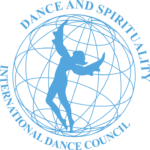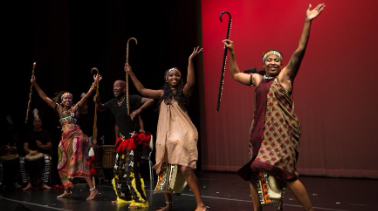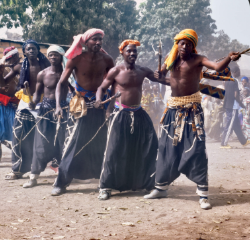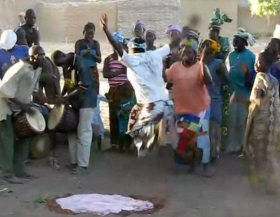GUINEA
The republic of Guinea is a country located in west Africa, on the coast of the Atlantic. Inside the country live a multitude of ethnic groups, having their own customs and traditions. These groups include the Fula, Mandinka, Susu, Kpelle, Kissi, Loma, Baga and many others. This cultural diversity has been victim to the brutal colonial campaign from the French, and the Portuguese which led to the erasure of the cultures of a lot of Guinean communities. Sadly, many dances of this country have been permanently erased. However, despite these challenges, a lot of these groups still thrive to this day and keep their customs alive.
This diversity of cultures is of course reflected in the dances that appear in the different communities of Guinea. Even today, many dances dating from the pre-colonial era still have an important role in the different cultures of Guinea. Dance is not only used for entertainment purposes but is also seen as integral to many customs. The art form has a spiritual dimension and is used to accompany every stage of life. It is used to celebrate, to respect the ancestors and to converse with the gods, to guarantee things such as good crops, fertility and good spirits. Dance is also a tool to consolidate the social order of the different communities of Guinea.
Sources :
List of Dances
Kakilembe
The Kakilembe is a ritual dance of the Baga people. It venerates the mask of the Kakilembe, a deity that embodies water, the rain, fire and the wind, who protects the communities from evil spirits.
The reports about the frequency of the ceremony seem to vary; it appears to be celebrated quite rarely, either once a year or once every seven years. The ceremony can last up to seven days, in which the music is not to be interrupted. The mask of Kakilembe is only to be handled by elders, dropping it on the ground is a sign of bad fortune. For each family of community, a string is attached to the mask. The ceremony grants the community good crops, fertility and protects them from famine and disease.
The rhythm of the music is played on various percussion instruments, including djembes. The time signatures can be 12/8, 6/8 or 4/4. The tempo varies a lot; during moments with slow tempo, the priest of the community communicates with Kakilembe. When he transmits what he heard from the deity to the village, the tempo accelerates and can be up to three times faster than before.
GUINEA
Ethnic group: Baga
Region: Boké, Kindia (West Guinea(coastal regions)
Dununba
The Dununba, also known as the “dance for strong men” originated in the Hamanah-Region and spread over northern Guinea. The dance is both a social ritual and a source of amusement for the community. It is used to resolve conflict and define the social order between the men.
The men of the village are divided into five different age groups, from the young boys (baradogono) to the eldest (barati). During the dance, the youngest often learn from the older age groups, and have the opportunity to prove their maturity through their performance. The Dununba takes place during one whole day with only very short breaks. The dancers perform various acrobatic moves, while being struck by elders with a riding crop. Dancers also use weapons, such as decorated hatchets, as accessories (see video 1). It is also an event where rivalries between men are settled, sometimes even through violent physical combat. A successful completion of the custom not only consolidates the social order but is also seen as proof of the courage and strength of the members of the community.
The rhythms of the music have a complex structure, following an 12/8 time signature. In the original ceremonies, the tempo was known to be slow. It can however vary during the ceremony, thus accentuating the intensity of the conflicts between different dancers.
Nowadays, the dununba-rhythms are also being played outside of the custom of the “dance of the strong men” and are celebrated and danced to by all the members of the community, regardless of gender or age. (see video 2)
GUINEA
Region: Upper Guineau (Kankan, Siguiri, Koroussa)
Ethnic group: Malinke and Hamanah
Country: Guinea, Gambia, Guinea-Bissau, Mali, Sierra Leone, Liberia, Ivory Coast
Moribayassa
The term Moribayassa can be translated to “death-dance” (“Mori” meaning death, “bayassa” meaning dance”). It is a dance performed by the Malinke to celebrate the rebirth of a woman who overcame personal struggles (such as infertility, grief or illness). The ceremony has the goal of restoring her cosmic equilibrium, as well as paying respects to the ancestors.
The dance is uniquely performed by women and girls, with the one who overcame her struggle in the center. It is seen as a sort of last resort: a woman going through struggle will try all the options to improve her situation (such as seeing a fetish maker). But if her problem persists, she will make a vow to dance the Moribayassa once she has overcome it. A woman can only do this once in her lifetime, and thus only makes this vow in a moment of great need.
Once she overcomes her struggle, which can be years after her vow, she and the other women of the community circle the village while dancing and singing. The woman wears colorful, revealing and purposely mismatched rags to symbolize a kind of delirious, maniac euphoria that unbinds her from all social norms. After the ceremony, these clothes are buried under a mango tree.
The dance particularly accentuates the movements of the lower body. The music is played on drums such as djembes, representing a heartbeat. The tempo can be quite fast, expressing the euphoria and energy of the celebration. Maybe because of this joyful character, the dance is nowadays also performed during festive celebrations The music, which is particularly polyrhythmic, is played by musicians around the world.
GUINEA
Ethnic Group: Malinke
Region: Eastern Guinea (among others)
Countries: Guinea, Gambia, Guinea-Bissau, Mali, Sierra Leone, Liberia, Ivory Coast



